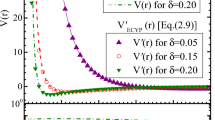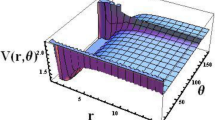Abstract
We report the bound state solutions of a novel non-central potential, the Eckart plus a ring-shaped potential, in the Klein–Gordon equation by using the Nikiforov–Uvarov method. We apply a developed scheme to overcome the centrifugal term. The energy eigenvalues and the corresponding normalised wave function of a mentioned system are presented in a closed and compact form. We also discuss various special cases related to our considered potential which are utility for other physical systems, consistent with previous studies. We then compute the eigenvalues and eigenfunctions numerically for arbitrary quantum numbers to show the accuracy of our results. It is shown that our results are sensitive to the parameter \(\delta\) as well as the quantum numbers \(n_{\textrm{r}}\) and N or l, as expected.





Similar content being viewed by others
Data Availability
The present work has no associated data or the data will not be deposited. [Authors’ comment: This is a theoretical study and no experimental data.]
References
W. Greiner, Relativistics Quantum Mechanics, 3rd edn. (Springer, Berlin, 2000). https://doi.org/10.1007/978-3-662-04275-5
V.G. Bagrov, D.M. Gitman, Exact Solutions of Relativistic Wave Equations (Kluwer Academic Publishers, Dordrecht, 1990). https://www.springer.com/gp/book/9780792302155
A.F. Nikiforov, V.B. Uvarov, Special Functions of Mathematical Physics (Birkhäuser, Basel, 1988). https://doi.org/10.1007/978-1-4757-1595-8
F. Cooper, A. Khare, U. Sukhatme, Phys. Rep. 251, 267 (1995). https://doi.org/10.1016/0370-1573(94)00080-M
F. Cooper, A. Khare, U. Sukhatme, Supersymmetry in Quantum Mechnics (World Scientific, 2001). https://doi.org/10.1142/4687
L.E. Gendenshtein, JETP Lett. 38, 356 (1983) http://jetpletters.ru/ps/1822/article_27857.pdf
L.E. Gendenshtein, I.V. Krive, Sov. Phys. Usp. 28, 645 (1985). https://doi.org/10.1070/PU1985v028n08ABEH003882
S.H. Dong, Factorization Method in Quantum Mechanics (Springer, Dordrecht, 2007). https://doi.org/10.1007/978-1-4020-5796-0
H. Ciftci, R.L. Hall, N. Saad, J. Phys. A Math. Gen. 36, 11807 (2003). https://doi.org/10.1088/0305-4470/36/47/008
A.Z. Tang, F.T. Chan, Phys. Rev. A 35, 911 (1987). https://doi.org/10.1103/PhysRevA.35.911
B. Roy, R. Roychoudhury, J. Phys. A Math. Gen. 20, 3051 (1987). https://doi.org/10.1088/0305-4470/20/10/048
J.M. Cai, P.Y. Cai, A. Inomata, Phys. Rev. A 34, 4621 (1986). https://doi.org/10.1103/PhysRevA.34.4621
P.M. Stevenson, Phys. Rev. D 23, 2916 (1981). https://doi.org/10.1103/PhysRevD.23.2916
O. Klein, Z. Phys. 37, 895 (1926). https://doi.org/10.1007/BF01397481
V. Fock, Z. Phys. 38, 242 (1926). https://doi.org/10.1007/BF01399113
V. Fock, Z. Phys. 39, 226 (1926). https://doi.org/10.1007/BF01321989
W. Gordon, Z. Phys. 40, 117 (1926). https://doi.org/10.1007/BF01390840
M. Znojil, J. Phys. A Math. Gen. 14, 383 (1981). https://doi.org/10.1088/0305-4470/14/2/015
F. Dominguez-Adame, Phys. Lett. A 136, 175 (1989). https://doi.org/10.1016/0375-9601(89)90555-0
G. Chen, Z.D. Chen, Z.M. Lou, Phys. Lett. A 331, 374 (2004). https://doi.org/10.1016/j.physleta.2004.09.032
C.L. Pekeris, Phys Rev. 45, 98 (1934). https://doi.org/10.1103/PhysRev.45.98
R.L. Greene, C. Aldrich, Phys. Rev. A 14, 2363 (1976). https://doi.org/10.1103/PhysRevA.14.2363
C.S. Jia, T. Chen, L.G. Cui, Phys Lett. A 373, 1621 (2009). https://doi.org/10.1016/j.physleta.2009.03.006
S.M. Ikhdair, Eur. Phys. J. A 39, 307–314 (2009). https://doi.org/10.1140/epja/i2008-10715-2
S.H. Dong, W.C. Qiang, G.H. Sun, V.B. Bezerra, J. Phys. A Math. Theor. 40, 10535 (2007). https://doi.org/10.1088/1751-8113/40/34/010
G.F. Wei, S.H. Dong, Phys. Lett. A 373, 49 (2008). https://doi.org/10.1016/j.physleta.2008.10.064
W.C. Qiang, S.H. Dong, Phys. Scr. 79, 045004 (2009). https://doi.org/10.1088/0031-8949/79/04/045004
H.I. Ahmadov, C. Aydin, N.S. Huseynova, O. Uzun, Int. J. Mod. Phys. E 22, 1350072 (2013). https://doi.org/10.1142/S0218301313500729
A.I. Ahmadov, C. Aydin, O. Uzun, Int. J. Mod. Phys. A 29, 1450002 (2014). https://doi.org/10.1142/S0217751X1450002X
H.I. Ahmadov, S.I. Jafarzade, M.V. Qocayeva, Int. J. Mod. Phys. A 30, 1550193 (2015). https://doi.org/10.1142/S0217751X15501936
V.H. Badalov, Int. J. Mod. Phys. E 25, 1650002 (2016). https://doi.org/10.1142/S0218301316500026
A.I. Ahmadov, S.M. Aslanova, M.S. Orujova, S.V. Badalov, S.H. Dong, Phys. Lett. A 383, 3010 (2019). https://doi.org/10.1016/j.physleta.2019.06.043
A.I. Ahmadov, M. Demirci, M.F. Mustamin, S.M. Aslanova, M.S. Orujova, Eur. Phys. J. Plus 136, 208 (2021). https://doi.org/10.1140/epjp/s13360-021-01163-y
J.Y. Guo, Z.Q. Sheng, Phys. Lett. A. 338, 90 (2005). https://doi.org/10.1016/j.physleta.2005.02.026
C. Berkdemir, A. Berkdemir, R. Sever, J. Phys. A Math. Gen. 39, 13455 (2006). https://doi.org/10.1088/0305-4470/39/43/005
V.H. Badalov, H.I. Ahmadov, S.V. Badalov, Int. J. Mod. Phys. E 19, 1463 (2010). https://doi.org/10.1142/S0218301310015862
G.F. Wei, Z.Z. Zhen, S.H. Dong, Cent. Eur. J. Phys. 7, 175 (2009). https://doi.org/10.2478/s11534-008-0143-9
C.S. Jia, T. Chen, S. He, Phys. Lett. A 377, 682 (2013). https://doi.org/10.1016/j.physleta.2013.01.016
G.F. Wei, S.H. Dong, Phys. Lett. B. 686, 288 (2010). https://doi.org/10.1016/j.physletb.2010.02.070
A. Arda, R. Sever, J. Math. Phys. 52, 092101 (2011). https://doi.org/10.1063/1.3641246
M. Hamzavi, S.M. Ikhdair, K.E. Thylwe, Chin. Phys. B 22, 040301 (2013). https://doi.org/10.1088/1674-1056/22/4/040301
Z. Wang, Z.W. Long, C.Y. Long, L.Z. Wang, Indian J. Phys. 89, 1059 (2015). https://doi.org/10.1007/s12648-015-0677-9
C.Y. Chen, D.S. Sun, F.L. Lu, Phys. Lett. A 370, 219 (2007). https://doi.org/10.1016/j.physleta.2007.05.079
A.N. Ikot, L.E. Akpabio, E.J. Uwah, Electron. J. Theor. Phys. 8, 225 (2011). http://ejtp.com/articles/ejtpv8i25p225.pdf
M. Simsek, H. Egrifes, J. Phys. A Math. Gen. 37, 4379 (2004). https://doi.org/10.1088/0305-4470/37/15/007
H. Egrifes, R. Sever, Int. J. Theoret. Phys. 46, 935 (2007). https://doi.org/10.1007/s10773-006-9251-8
W.C. Qiang, R.S. Zhou, Y. Gao, Phys. Lett. A 371, 201 (2007). https://doi.org/10.1016/j.physleta.2007.04.109
W.C. Qiang, Chin. Phys. 13, 575 (2004). https://doi.org/10.1088/1009-1963/13/5/002
O.J. Oluwadare, K.J. Oyewumi, O.A. Babalola, Afr. Rev. Phys. 7, 0016 (2012). http://lamp.ictp.it/index.php/aphysrev/article/view/543
A.I. Ahmadov, M. Naeem, M.V. Qocayeva, V.A. Tarverdiyeva, Int. J. Mod. Phys. A 33, 1850021 (2018). https://doi.org/10.1142/S0217751X18500215
A.I. Ahmadov, M. Demirci, S.M. Aslanova, M.F. Mustamin, Phys. Lett. A 384, 126372 (2020). https://doi.org/10.1016/j.physleta.2020.126372
A.I. Ahmadov, S.M. Nagiyev, M.V. Qocayeva, K. Uzun, V.A. Tarverdiyeva, Int. J. Mod. Phys. A 33, 1850203 (2018). https://doi.org/10.1142/S0217751X18502032
P. Aspoukeh, S.M. Hamad, Chin. J. Phys. 68, 224 (2020). https://doi.org/10.1016/j.cjph.2020.09.002
I.J. Njoku, E. Onyeocha, C.P. Onyenegecha, M. Onuoha, E.K. Egeonu, P. Nwaokafor, Int. J. Quantum Chem. 2022, e27050 (2022). https://doi.org/10.1002/qua.27050
H. Hartmann, Theor. Chim. Acta. 24, 201 (1972). https://doi.org/10.1007/BF00641399
A. Hautot, J. Math. Phys. 14, 1320 (1973)
S.H. Dong, G.H. Sun, M.L. Gassou, Phys. Lett. A 328, 299 (2005). https://doi.org/10.1016/j.physleta.2004.06.037
C.Y. Chen, S.H. Dong, Phys. Lett. A 335, 374 (2005). https://doi.org/10.1016/j.physleta.2004.12.062
A.D. Alhaidari, J. Phys. A Math. Gen. 38, 3409 (2005). https://doi.org/10.1088/0305-4470/38/15/012
H. Karayer, D. Demirhan, Eur. Phys. J. Plus 137, 527 (2022). https://doi.org/10.1140/epjp/s13360-022-02755-y
S.H. Dong, M. Lozada-Cassou, Phys. Scr. 74, 285 (2006). https://doi.org/10.1088/0031-8949/74/2/024
S.M. Nagiyev, A.I. Ahmadov, Int. J. Mod. Phys. A 34, 1950089 (2019). https://doi.org/10.1142/S0217751X19500891
S.M. Nagiyev, A.I. Ahmadov, V.A. Tarverdiyeva, Adv. High Energy Phys. 2020, 1356384 (2020). https://doi.org/10.1155/2020/1356384
C. Eckart, Phys. Rev. 35, 1303 (1930). https://doi.org/10.1103/PhysRev.35.1303
J.J. Weiss, J. Chem. Phys. 41, 1120 (1964). https://doi.org/10.1063/1.1726015
A. Cimas, M. Aschi, C. Barrientos, V.M. Rayón, J.A. Sordo, A. Largo, Chem. Phys. Lett. 374, 594 (2003). https://doi.org/10.1016/S0009-2614(03)00771-1
W. Lucha, F.F. Shöberl, Int. J. Mod. Phys. C 10, 607 (1999). https://doi.org/10.1142/S0129183199000450
X.Y. Liu, G.F. Wei, C.Y. Long, Int. J. Theor. Phys. 48, 463 (2009). https://doi.org/10.1007/s10773-008-9821-z
A.A. Khelashvili, T.P. Nadareishvili, Am. J. Phys. 79, 668 (2011). https://doi.org/10.1119/1.3546099
A.A. Khelashvili, T.P. Nadareishvili, Phys. Part. Nucl. Lett. 12, 11 (2015). https://doi.org/10.1134/S1547477115010148
A.A. Khelashvili, T.P. Nadareishvili, Int. J. Mod. Phys. E 26, 1750043 (2017). https://doi.org/10.1142/S0218301317500434
M. Abramowitz, I.A. Stegun, Handbook of Mathematical Functions with Formulas, Graphs and Mathematical Tables (Dover, New York, 1964). https://doi.org/10.1119/1.15378
Acknowledgements
The work of M. Demirci was supported by the Scientific and Technological Research Council of Turkey (TUBITAK) in the framework of 2219-International Postdoctoral Research Fellowship Program. We would like to thank the anonymous reviewers for the positive suggestions, which have greatly helped us in making improvements to this paper.
Author information
Authors and Affiliations
Corresponding author
Appendix A: Nikiforov–Uvarov method
Appendix A: Nikiforov–Uvarov method
The NU method has been a very useful tool in the fields of physics and applied mathematics since its introduction. The power of the method in obtaining the energy levels of all bound states for some solvable quantum systems has been proven by many works [24, 35, 36, 41, 42, 45, 46, 51, 53, 54].
In this section, we briefly introduce the NU method [3]. It is used to solve the second-order differential equations that can be converted to a generalized equation of hypergeometric-type in the following form
where the coefficients \(\sigma (x)\) and \({\tilde{\sigma }}(x)\) can be a maximum second-order polynomial while \({\tilde{\tau }}(x)\) can be a first-order kind. A particular solution of the above equation is constructed as a multiple of two independent parts:
It reduces Eq. (A.1) to a hypergeometric-type equation,
The function \(\phi (x)\) needs to satisfy the logarithmic derivative
with
where primes denote the derivative according to x and it can be first-order at most. The k-values in Eq. (A.5) are possible to be evaluated if the expression under the square root must be a square of polynomial. This is possible, if and only if its discriminant is zero, i.e. \(\varDelta =b^2-4 a c =0\).
As a result, the equation reduces to a hypergeometric type equation, where one of its solutions is \(y_n(x)\). Hence the polynomial expression \({\bar{\sigma }}(x)=\tilde{\sigma }(x)+\pi ^2(x)+\pi (x)[\tilde{\tau }(x)-\sigma ^{'}(x)]+\pi ^{'}(x)\sigma (x)\) can be divided by a factor of \(\sigma (x)\), such that \({\bar{\sigma }}/\sigma (x)=\lambda\). Here, we consider the following relations
where \(\tau (x)\) must have a negative derivative. A unique n-degree polynomial solution can be found for the hypergeometric type equation if
Accordingly, the energy spectrum equation is obtained from a relationship between Eqs. (A.6) and (A.8).
On the other hand, the polynomial solution \(y_n(x)\), which is the hypergeometric type function, is given by the Rodrigues relation
where \(C_n\) is the normalization constant, and \(\rho (x)\) stands for the weight function. The weight function \(\rho (x)\) obeys [3]
which is called as the Pearson differential equation.
Rights and permissions
Springer Nature or its licensor (e.g. a society or other partner) holds exclusive rights to this article under a publishing agreement with the author(s) or other rightsholder(s); author self-archiving of the accepted manuscript version of this article is solely governed by the terms of such publishing agreement and applicable law.
About this article
Cite this article
Ahmadov, A.I., Demirci, M., Mustamin, M.F. et al. Bound state solutions of the Klein–Gordon equation under a non-central potential: the Eckart plus a ring-shaped potential. Eur. Phys. J. Plus 138, 92 (2023). https://doi.org/10.1140/epjp/s13360-023-03715-w
Received:
Accepted:
Published:
DOI: https://doi.org/10.1140/epjp/s13360-023-03715-w




